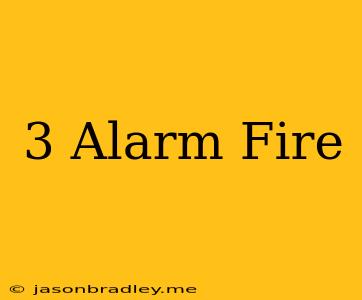What is a 3-Alarm Fire?
A 3-alarm fire is a significant fire incident that requires the response of three fire alarms, which usually translates to a large number of firefighters and equipment. These fires are often categorized as major incidents, demanding considerable resources and coordination to manage effectively.
Why Are 3-Alarm Fires So Serious?
Several factors contribute to the severity of 3-alarm fires:
- Size and Scope: The fire is likely large and expansive, requiring multiple fire engines, ladder trucks, and other specialized equipment.
- Intensity and Difficulty: The fire is likely intense and challenging to control, requiring sustained efforts to extinguish.
- Potential for Spread: The fire poses a significant risk of spreading to nearby structures or areas, necessitating quick and strategic action.
- Risk to Life and Property: The potential for loss of life or significant property damage is high.
Factors Triggering a 3-Alarm Response
A fire department might dispatch a 3-alarm response for several reasons, including:
- Large Structure Fires: Fires in large buildings like warehouses, factories, or multi-story apartments often require significant resources.
- Difficult Fire Conditions: Fires in hard-to-reach locations, such as high-rise buildings or underground structures, might necessitate a 3-alarm response.
- Hazardous Materials: Fires involving hazardous materials like chemicals or explosives demand specialized equipment and expertise.
- Multiple Fires: Simultaneous fires in different locations within a city or region could trigger a 3-alarm response.
- Severe Weather Conditions: High winds, extreme heat, or other weather conditions that could exacerbate the fire might require additional resources.
The Role of the Fire Department
In a 3-alarm fire, the fire department plays a crucial role in:
- Dispatching Firefighters and Equipment: The fire department dispatches multiple fire companies, ladder trucks, and other necessary equipment to the fire scene.
- Establishing Command: A fire chief or officer assumes command of the incident, coordinating the efforts of all responding units.
- Controlling the Fire: Firefighters use various tactics and strategies to extinguish the fire and prevent its spread.
- Evacuation and Rescue: In cases involving buildings, firefighters prioritize the evacuation of occupants and the rescue of anyone trapped inside.
- Damage Assessment and Investigation: Once the fire is extinguished, the fire department conducts a thorough damage assessment and investigates the cause of the fire.
Conclusion
3-alarm fires represent significant emergencies requiring substantial resources and expertise to manage. They pose a considerable threat to life, property, and public safety. The fire department's well-coordinated efforts and the efficient deployment of resources are essential in containing these incidents and minimizing their impact.
